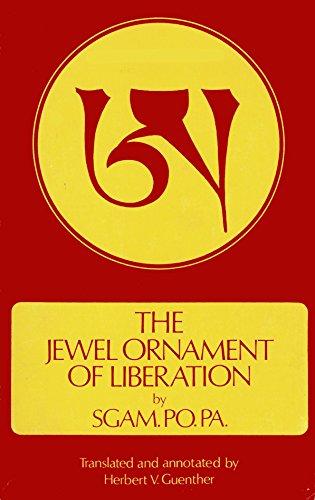The very first English translation of Gampopa’s 12th-century guidebook to awakening, by the German scholar Herbert Guenther, was published in 1959, and reissued in 1971 with a cover design and foreword by Chogyam Trungpa Rinpoche. It thus has excellent credentials and blessings, and it made available to the West for the first time the systematized Kagyu path to awakening from A to Z.
I still find Guenther’s translation occasionally the most spot-on (in my opinion), but it was a pioneering effort, and he translated the title as The Jewel Ornament of Liberation. This title has stuck for 60 years, even though we now know it to be slightly incorrect.
It was also used by Khenpo Konchog Gyaltsen Rinpoche for his widely-read, modernized translation, published in 1998. There’s also a third translation, by Ken and Katia Holmes, published in 1995, whose title takes a completely different approach: Gems of Dharma, Jewels of Freedom; but this one has been superseded by Ken’s 2017 revision under the title Ornament of Precious Liberation, which Situ Rinpoche has taught to be the correct interpretation of the Tibetan title: tar.pa.rin.po.chei.gyen.
In short, it’s the liberation that is precious, not the ornament. The book itself is meant (by Gampopa) to be the ornament that adorns liberation, which is the precious goal to which his text points. But whether we call it the Jewel Ornament or the Ornament of Precious Liberation, it’s the same text, and all translations have their individual merits, though I mostly rely on Ken’s most recent one.
Tibetans familiarly refer to the text as dak.po.tar.gyen. Dakpo refers to the author, Gampopa, who was born in the Dakpo region of central Tibet and for whom the Dakpo Kagyu lineage was likewise named. tar.gyen means ornament of liberation, which is shorthand for the full title.
This explanation is not necessary for understanding the book and the path; you might say it’s a (feeble) adornment of the adornment — the adornment of precious liberation, realization of our innate buddha nature, which is the point of it all.
The only thing you need to take away from this post is that Gampopa’s book has various titles and it’s fine to use any of the translations, though according to Situ Rinpoche, the correct title is Ornament of Precious Liberation. The image below is of Trungpa Rinpoche’s cover design for the 1971 edition of Guenther’s original translation.

No recording for this post.
Next: Gampopa’s introduction: the case for waking up
